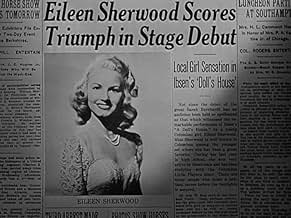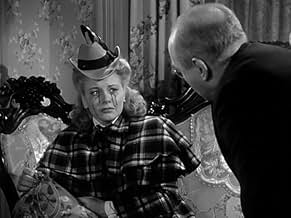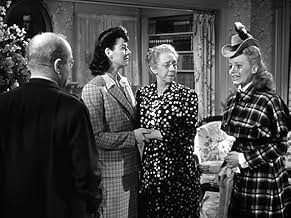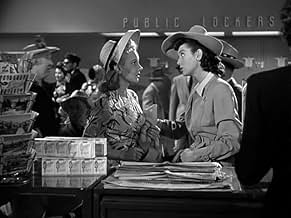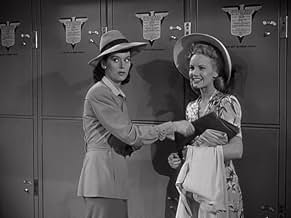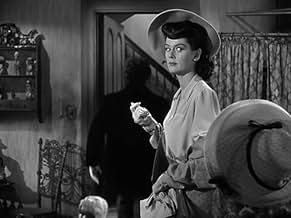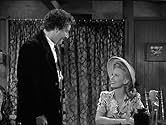AVALIAÇÃO DA IMDb
7,0/10
1,8 mil
SUA AVALIAÇÃO
Adicionar um enredo no seu idiomaTwo sisters move from Ohio to New York with hopes of stardom.Two sisters move from Ohio to New York with hopes of stardom.Two sisters move from Ohio to New York with hopes of stardom.
- Direção
- Roteiristas
- Artistas
- Indicado a 1 Oscar
- 2 vitórias e 1 indicação no total
Jeff Donnell
- Helen Loomis
- (as Miss Jeff Donnell)
George Adrian
- Cadet
- (não creditado)
Kirk Alyn
- Portuguese Merchant Marine Cadet
- (não creditado)
Don Barclay
- Drunk
- (não creditado)
Richard Bartell
- Lothario in Bus Terminal
- (não creditado)
Avaliações em destaque
ROSALIND RUSSELL was always at her best in comedies and here she had a role that got her an Oscar nomination for Best Actress in 1942--and it's easy to see why. She's downright hilarious as the gal from Ohio with writing ambitions and a pretty blonde sister (JANET BLAIR) with a penchant for attracting men and trouble.
All the wacky situations stem from their Greenwich Village basement apartment which seems to have more visitors than Grand Central Station. It's all exaggerated fluff, but it works, thanks to a fine cast and sterling performances.
RICHARD QUINE and GORDON JONES do repeats of their Broadway roles, and DONALD MacBRIDE as a policeman who wants quiet on his route is hilarious. JUNE HAVOC makes a brief appearance as a medium who used to live in the girls' apartment. GEORGE TOBIAS, as the opportunistic landlord with the Greek accent, is at his funniest in a colorful supporting role.
My favorite moment is the conga sequence with Russell and Blair trying to get rid of sailors who don't speak a word of English, creating a disturbance that lands Blair in jail. Janet Blair is pleasant as the blonde bombshell but it's Russell who milks the most out of her role and gets all the laughs. She's terrific.
BRIAN AHERNE does what he can with the role of the talkative editor, but it's not much of a part. Still, he adds a certain debonair charm to the role.
Summing up: Notable chiefly as a terrific vehicle for Russell's unique brand of comic talent.
All the wacky situations stem from their Greenwich Village basement apartment which seems to have more visitors than Grand Central Station. It's all exaggerated fluff, but it works, thanks to a fine cast and sterling performances.
RICHARD QUINE and GORDON JONES do repeats of their Broadway roles, and DONALD MacBRIDE as a policeman who wants quiet on his route is hilarious. JUNE HAVOC makes a brief appearance as a medium who used to live in the girls' apartment. GEORGE TOBIAS, as the opportunistic landlord with the Greek accent, is at his funniest in a colorful supporting role.
My favorite moment is the conga sequence with Russell and Blair trying to get rid of sailors who don't speak a word of English, creating a disturbance that lands Blair in jail. Janet Blair is pleasant as the blonde bombshell but it's Russell who milks the most out of her role and gets all the laughs. She's terrific.
BRIAN AHERNE does what he can with the role of the talkative editor, but it's not much of a part. Still, he adds a certain debonair charm to the role.
Summing up: Notable chiefly as a terrific vehicle for Russell's unique brand of comic talent.
While this could not be considered a classic by any means, it is very enjoyable and a fun way to spend an afternoon. The humor is on point, but at times I felt like I was supposed to laugh when I didn't feel like laughing. Other than that, it was great. They didn't try to pad out the plot, and the plot that was there ran smoothly.
The ending was slightly implausible and too happy-sappy for me, but for the most part it didn't drag down the quality of the film.
Rosalind Russell was good, as usual, and Janet Blair was good as the sister Eileen. The rest of the characters that drift in and out of the lodgings of Eileen and Ruth (Roz Russell's character) have varying levels of effect. I liked the Portuguese soldiers, but I understand that some of the stereotypes might be considered a little dated. It's still good fun, though.
If you're a Roz Russell fan or a classic film lover, I reccomend this one.
The ending was slightly implausible and too happy-sappy for me, but for the most part it didn't drag down the quality of the film.
Rosalind Russell was good, as usual, and Janet Blair was good as the sister Eileen. The rest of the characters that drift in and out of the lodgings of Eileen and Ruth (Roz Russell's character) have varying levels of effect. I liked the Portuguese soldiers, but I understand that some of the stereotypes might be considered a little dated. It's still good fun, though.
If you're a Roz Russell fan or a classic film lover, I reccomend this one.
...Or maybe it is "Those Girls"?
This film stars Rosalind Russell as Ruth Sherwood, an aspiring writer, who moves from small town Columbus, OH to New York with her sister, Eileen (Janet Blair), an aspiring actress. Ruth and Eileen's father does not approve of his unmarried daughters moving to the city to pursue their careers, but grandma wholly approves and all but forces her son to let them go. ("Let?"- my understanding is both are adults - but then this is 1942) In New York, with limited funds ($100), the ladies look for a place to live. They end up at this apartment in Greenwich Village where, as a result of lack of sleep and desire to keep looking, they end up agreeing to a trial stay in the basement of the building. The deal is that they can live in the apartment for a month for free and if they like it, the rent will be $45/month afterward. If they hate the apartment, the landlord (Abner Kravitz with a big wig and mustache) will give them $45 for their trouble. The girls decide to stay, but there are lots of problems with this apartment.
The apartment is above a section where they are blasting the rock to build a subway. The girls are occasionally jolted by the explosions. Since Ruth and Eileen are in a basement apartment, they have the street pedestrian traffic walking past their windows. Their neighbors also seem to let themselves in willy nilly into their apartment. Also a previous tenant, Effie, whose career as a prostitute is alluded to, still has her Johns coming to her old place for a "psychic reading." Meanwhile, while all this is going on, Ruth and Eileen are trying to find jobs in writing and acting, respectively.
Eileen seems to have an almost hypnotic affect on men, rending Ruth practically invisible. Ruth ends up meeting the editor (Brian Aherne) of a magazine, The Mad Hatten, a magazine desperately in need of updating. I liked Aherne and Russell together. I thought that Aherne's calm, sophisticated demeanor complimented Russell's more wacky one. Russell and Janet Blair were excellent executing their physical comedy scenes--the conga line with the Portuguese Navy was especially funny--and must have been exhausting!
A final note - because they are short on funds the sisters are reduced to eating the cheapest of foods - spaghetti. This may be the first film that proposes the Atkins diet when Ruth mentions that eating only spaghetti (high carb) is making her fat.
Recommended for fans of classic comedy and carb counters everywhere.
This film stars Rosalind Russell as Ruth Sherwood, an aspiring writer, who moves from small town Columbus, OH to New York with her sister, Eileen (Janet Blair), an aspiring actress. Ruth and Eileen's father does not approve of his unmarried daughters moving to the city to pursue their careers, but grandma wholly approves and all but forces her son to let them go. ("Let?"- my understanding is both are adults - but then this is 1942) In New York, with limited funds ($100), the ladies look for a place to live. They end up at this apartment in Greenwich Village where, as a result of lack of sleep and desire to keep looking, they end up agreeing to a trial stay in the basement of the building. The deal is that they can live in the apartment for a month for free and if they like it, the rent will be $45/month afterward. If they hate the apartment, the landlord (Abner Kravitz with a big wig and mustache) will give them $45 for their trouble. The girls decide to stay, but there are lots of problems with this apartment.
The apartment is above a section where they are blasting the rock to build a subway. The girls are occasionally jolted by the explosions. Since Ruth and Eileen are in a basement apartment, they have the street pedestrian traffic walking past their windows. Their neighbors also seem to let themselves in willy nilly into their apartment. Also a previous tenant, Effie, whose career as a prostitute is alluded to, still has her Johns coming to her old place for a "psychic reading." Meanwhile, while all this is going on, Ruth and Eileen are trying to find jobs in writing and acting, respectively.
Eileen seems to have an almost hypnotic affect on men, rending Ruth practically invisible. Ruth ends up meeting the editor (Brian Aherne) of a magazine, The Mad Hatten, a magazine desperately in need of updating. I liked Aherne and Russell together. I thought that Aherne's calm, sophisticated demeanor complimented Russell's more wacky one. Russell and Janet Blair were excellent executing their physical comedy scenes--the conga line with the Portuguese Navy was especially funny--and must have been exhausting!
A final note - because they are short on funds the sisters are reduced to eating the cheapest of foods - spaghetti. This may be the first film that proposes the Atkins diet when Ruth mentions that eating only spaghetti (high carb) is making her fat.
Recommended for fans of classic comedy and carb counters everywhere.
It's a circus, but you don't need an admission ticket. You can even peek in from the street and catch all the antics on your way to work. It's Ruth and Eileen's sub-level flat, and rents for only $48 a month with open grillwork onto a chaotic Greenwich Village street scene. Are these two ambitious Mid-western sisters ready for a pro-football player who sleeps over, a fast-talking landlord who paints like a Dodo bird, and a mysterious stranger who walks in and refuses to leave, Then there's the battalion of Portuguese naval cadets who mistake the flat for a dance studio. It's all part of this wacky, fast-paced take on Life in the Big City.
It's all good, innocent fun of course with a tempo that seldom falters, and when things do slow, there's always an underground jolt to mix it up again. Naturally, Rosalind Russell as the caustic older sister gets all the good throw-away lines, while Janet Blair as Eileen gets all the wolf whistles. Then there's the assorted characters-- Gordon Jone's trademark good-natured galoot, George Tobias' fractured ethnic type, and Chick Chandler's silent stranger more creepy than humorous. And, of course, no urban scene of the day would be complete without the bulldog-face of Donald McBride as the ever cranky cop. Together, they turn the flat into a stopover on the way to the funny farm. I expect more than a few Mid-Westerners packed up for New York hoping to get a share of madcap city life.
On a more serious note, the movie was made at a time when the "common touch" was being celebrated in popular culture. After all, it would take a combined national effort to defeat the Axis powers. So, it's not surprising that many movies celebrated the America of the "melting pot", complete with ethnic types, blue-collar characters, and frequent references to Brooklyn, the symbol of the melding.
Anyway, it's still a fun movie even if some skits do strain a bit. I guess the moral is that no city is too big for the talented. And especially, for the shapely. Then too, make sure to stick around for a very last scene that could not be more inspired or appropriate.
It's all good, innocent fun of course with a tempo that seldom falters, and when things do slow, there's always an underground jolt to mix it up again. Naturally, Rosalind Russell as the caustic older sister gets all the good throw-away lines, while Janet Blair as Eileen gets all the wolf whistles. Then there's the assorted characters-- Gordon Jone's trademark good-natured galoot, George Tobias' fractured ethnic type, and Chick Chandler's silent stranger more creepy than humorous. And, of course, no urban scene of the day would be complete without the bulldog-face of Donald McBride as the ever cranky cop. Together, they turn the flat into a stopover on the way to the funny farm. I expect more than a few Mid-Westerners packed up for New York hoping to get a share of madcap city life.
On a more serious note, the movie was made at a time when the "common touch" was being celebrated in popular culture. After all, it would take a combined national effort to defeat the Axis powers. So, it's not surprising that many movies celebrated the America of the "melting pot", complete with ethnic types, blue-collar characters, and frequent references to Brooklyn, the symbol of the melding.
Anyway, it's still a fun movie even if some skits do strain a bit. I guess the moral is that no city is too big for the talented. And especially, for the shapely. Then too, make sure to stick around for a very last scene that could not be more inspired or appropriate.
Abner! Abner! yup, that's George Tobias from "Bewitched" behind the wig and over-sized mustache playing the bushy/pushy artist and landlord in this first film version of "My Sister Eileen". Rosalind Russell and Janel Blair are sisters who come from Ohio to the big city to find fame and fortune in New York. There are some clever lines, mostly given to Russell, but it must be the direction of Alexander Hall holding this back. The Three Stooges make an appearance, and a very flat-line Brian Aherne. He keeps stepping out of the woodwork to tell Ruth (Russell) that her stories will or will not be published. Viewers will recognize Donald MacBride as the neighborhood cop, trying to keep things under control. Gordon Jones is the out of work muscle guy from upstairs, married of course, since we're well into the Hays Code by this time. He always seems to play the wrestler, the truck driver, and people named "Tex". The girls have many adventures, but the Portuguese navy is involved, and for some reason, they put Eileen (Blair) in jail, which doesn't really make sense, but you have to buy into it. It probably made more sense before it was all whitewashed for the audience. The basic story must have good footings, since the film has been remade, and it was even turned into a TV show in the 1960s. Janet Blair, who had the least experience in films at the time, turns in the best acting performance. Interesting note- Frank Quine, who had played Lippincott in the 1942 film version, directed the 1955 remake starring Janet Leigh, Jack Lemmon, and Betty Garrett. Haven't seen that one yet, but it must have been pretty good, since that one made it to video. and the 1955 version was a musical! one odd connection - the 42 version has George Tobias, and the 1955 version has Dick York, both would end up on the TV show "Bewitched"
Você sabia?
- CuriosidadesThe movie is based on the real-life experiences of Ruth McKenney, and her sister Eileen. In 1934, Ruth and Eileen McKinney moved to New York from Columbus, Ohio. They rented a $45-a-month basement apartment at 14 Gay Street in Greenwich Village, above the Christopher Street subway station. Ruth wrote about their eccentric neighbors and the trials of living in a basement apartment in her column titled, "My Sister Eileen," which was published in "The New Yorker" (called "The Manhatter" in the movie). As seen in the film, "The New Yorker" editor Harold Ross was at first reluctant to publish Ruth McKinney's columns, preferring to keep his magazine a "High Society" publication, but he eventually relented. Ruth's columns were gathered in a book, "My Sister Eileen," which was published in 1938. Eileen McKinney moved to Los Angeles, where she married novelist and screenwriter Nathanael West (author of the perennial Hollywood novel, "The Day of the Locust"). Unfortunately, Eileen McKinney and Nathanael West were both killed in a car accident in Los Angeles on December 22, 1940, only four days before they were scheduled to attend the Broadway opening of the play, "My Sister Eileen." Ruth McKinney died in 1972 at age 60.
- Erros de gravaçãoWhen Bob puts Ruth in the taxicab outside of the police station, the shadow of the boom mic can be seen moving across the hood of the cab.
- Citações
'The Wreck' Loomis: [holding an iron] Which way do you want the pleats turned?
Ruth Sherwood: Toward Mecca.
- ConexõesReferenced in Acropolis Now: My Sister Aphroula (1990)
- Trilhas sonorasRamblin' Wreck from Georgia Tech
(uncredited)
Written by Billy Walthall, Frank Roman, Charles Ives and Michael Greenblatt
Sung by Gordon Jones
Principais escolhas
Faça login para avaliar e ver a lista de recomendações personalizadas
- How long is My Sister Eileen?Fornecido pela Alexa
Detalhes
- Data de lançamento
- País de origem
- Central de atendimento oficial
- Idioma
- Também conhecido como
- Solteira às Avessas
- Locações de filme
- Empresa de produção
- Consulte mais créditos da empresa na IMDbPro
- Tempo de duração1 hora 36 minutos
- Cor
- Proporção
- 1.37 : 1
Contribua para esta página
Sugerir uma alteração ou adicionar conteúdo ausente

Principal brecha
By what name was Solteiras às Soltas (1942) officially released in India in English?
Responda

